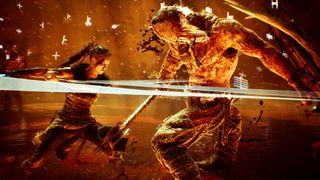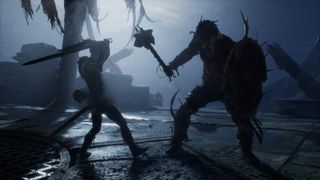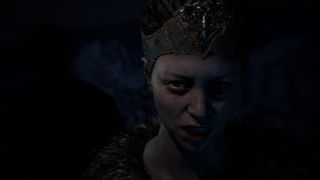Games like Hellblade are eroding the border between indie and triple-A
Standardized technology and collaboration are blurring the line between indie and big-budget games, and Senua's eyes are the proof.

Staring into the eyes of Senua, the heroine of Ninja Theory's latest game Hellblade, hurts like staring into the sun. Vibrant turquoise, her eyes cut as deeply as any of the viking weapons brandished against her and convey loss, anger, sorrow, confusion and courage in the space of a single heartbeat. They're easily among gaming's finest contemporary achievements, those eyes, and they're so real as to make the similar expressive work in The Witcher 3 look like sketchwork by comparison.
They're more than merely pretty: they mark a shift in the gaming industry as we've known it for much of the last decades. Senua’s eyes allow a glimpse of a gaming landscape where the lines between indie and so-called "triple-A" games are blurred. We're now finding better artistry in smaller projects. We're finding former mods like PlayerUnknown's Battlegrounds outselling the works of major publishers. And based on recent chats I had with Ninja Theory and Firewatch's Campo Santo, it all springs from a perfect storm of increasingly standardized technology, overlapping talent, and comparatively freeform distribution models. It may be precisely what gaming needs in order to evolve.
“Why would anyone want to play as a regular person instead of a space marine?”
It's fitting that Hellblade's story and its development both have roots in defiance. Ninja Theory achieved critical and commercial acclaim with 2007's Heavenly Sword and 2013's DmC, but it sought greater artistic achievements than "triple-A" development normally allows. Dominic Matthews, Ninja Theory's commercial director, tells me of a meeting a few years back when the studio was trying to pitch an open-world sci-fi game called Razer. They found themselves pressured to fill too many checkboxes for trendy features like multiplayer modes and mobile compatibility. And finally a publisher scoffed at their idea for a more human story than big-budget gaming normally gets with this response: "Why would anyone want to play as a regular person instead of a space marine?"

The moment was an awakening. "We looked at indie games with some envy," Matthews says, while waxing poetic about games like The Stanley Parable and Everybody’s Gone to the Rapture, both remarkable games that took risks larger publishers wouldn't. Elsewhere games like Goat Simulator were proving you no longer needed big budgets (or even production quality) to reach comparable sales.
With Hellblade, Ninja Theory saw a chance for studios to reboot the concept of "double-A" games in the vein of 2000’s Jet Set Radio. Games, in other words, with more ambition than a Limbo or Super Meat Boy, but less than a Destiny 2. Games that could play the wide-release art house flick to the super blockbuster, sort of like The King’s Speech appearing in the same theater as Dunkirk.
Under the hood
Matthews is quick to point out that Ninja Theory would had struggled to find this confidence just a few years ago when many high-profile games ran on custom engines. Nowadays though, widely used and relatively approachable standardized engines like Unreal 4 allow small teams to craft graphics that were once out of reach. He admires what other studios have achieved with landscapes and "walking simulators" in this regard, but the studio believed it wouldn't earn the "indie triple-A" feel it sought unless it could extend that quality to Hellblade’s characters as well.
There was, of course, more at stake besides hoping someone might cheer its "jaw-dropping graphics" in a Twitch stream or Steam review. Hellblade attempts to take a serious look at psychosis, and few of its goals were as important as getting players to understand what was going on beyond those soul-ripping eyes.
The biggest gaming news, reviews and hardware deals
Keep up to date with the most important stories and the best deals, as picked by the PC Gamer team.

"Our belief is that if you can relate to the character and believe in her, then you can engage on a far deeper emotional level," Matthews says. "Other games might not place too much attention on facial animations, but our story is a very personal journey. I think it's critical that you believe in Senua to go along on that ride with her."
Fortunately, today's widespread standardization also allows for easy collaboration. Filling in the blanks of a studio's skillset used to be a time-consuming and costly endeavor, but it's relatively painless now that contractors usually don't have to learn the intricacies of custom engines.
"We found that people want to find ways to work with independent developers," Matthews says. "If you want to use performance capture, license music, or use or you technology that you may be way outside of your price range, your best bet is to just have conversations with people."
So rather than tackling this effort themselves, Ninja Theory brought in contractors 3Lateral to create Senua's head and Cubic Motion to handle the animations. Working on a tight budget, Ninja Theory met them halfway. Rather than fly out to Los Angeles or New Zealand for motion capture as in previous projects, they built a DIY motion capture studio inside their Cambridge boardroom using parts from IKEA and Amazon.
Senua herself was modeled by Melina Juergens, Ninja Theory's own video editor rather than a professional actor. When they wanted similar detail for the ghostly Celtic monk Druth without spending the same kind of cash, they carefully incorporated live-action capture. The approach allowed them to play off their strengths and outsource only when they absolutely needed outside help to create that "triple-A" vibe.

"We always had the approach that we will make the game that we’re going to make and we will price it appropriately."
Dominic Matthews
I hear similar praise for the standardization of 3D graphical technology from Campo Santo's Sean Vanaman. It proved a blessing when working on Firewatch, as contractors could ditch the arcane initiation rites formerly required when joining a project midway through development. One globetrotting contractor, he tells me, initially didn't even have to download the core game files since she had ready access to Maya scripting tools. They merely needed to import her work upon completion.
"Basically, if you know how to use the Unreal or Unity engines, then you already know a ton about making games," Vanaman says. "So I feel like the flattening of standardized platforms allows people to compete across the board."
Vanaman points out that the fruits of this standardization extend far beyond games, to the point that indie game studios like Campo Santo can now draw from the same talent pools responsible for some of the highest-grossing films of all time.
"You end up with people who have been doing triple-A work who can just walk onto an indie team and already understand huge pieces of your pipeline,” Vanaman says. "On our new game, we brought on someone who'd worked at WETA Workshop. She was all like, 'I did all these things for The Hobbit,' and we were like, 'Yeah, um, you're good.'"

Digital: A Love Story
But nothing made Hellblade possible quite like the prevalence of digital distribution. Hellblade was entirely Ninja Theory's project, free from crowdfunding obligations, fluff like multiplayer modes, and trend-minded publishing execs who want every hero to be a space marine. Digital distribution allowed the blockbuster developer to become the publisher, to escape the tyranny of the $60 pricing model and all its implied requirements. Unfettered from the need to stretch Hellblade to 12 to 15 hours to justify that cost, Ninja Theory was able to make it as long as it needed for the maximum punch: a swift jab in the gut rather than a taxing triathlon.
"That was a really beautiful thing about Hellblade," he says. "We always had the approach that we will make the game that we’re going to make and we will price it appropriately."
And Matthews knows other studios are watching. They've told him. Hellblade's success could prove that studios with a big budget pedigree could go back to making the games they're passionate about making, while at the same time proving that smaller studios need not shy from projects demanding higher production values.

"There isn't a ceiling any more," Matthews says. "There isn't a level of quality of that can only be achieved by the big triple-A studios and games."
Campo Santo's Jake Rodkin believes that these developments have advanced far enough that the indie scene isn't shoved off to the side like it used to be. It stands shoulder-to-shoulder with the former giants.
"One thing that struck me about PAX West this year was the smooth scale range of games on the floor from small 'bedroom indies' all the way to the hugest triple-A releases," Rodkin says. "Seeing this range of games all coexisting in the same space made me hope that we’re about to see a wider range of games on as wide a range of possible."
All of which brings us back to Senua’s wonderfully sculpted eyes. They’re terrible to meet head on, but there are better things lurking in there besides fear and uncertainty. There's also hope. There's determination. Stare at them long enough, and they look a little like the future.
Most Popular

